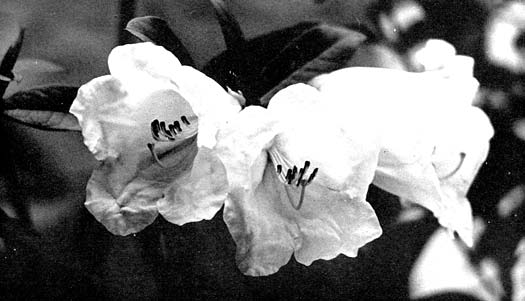QBARS - v9n3 R. lindleyi
R. lindleyi
Wales and Ruth Wood, St. Helens, Oregon

|
|
Fig. 37.
R. lindleyi
Wood photo |
Temptation presented itself when we saw that R. Lindleyi had outgrown its greenhouse home in Mr. and Mrs. Greig's garden on northern Vancouver Island. The Greigs were loath to risk outdoor temperature lows at their location. We have been growing R. megacalyx , R. crassum , R. boothii , R. bullatum and flowering R. johnstoneanum , 'Fragrantissimum' and 'Lady Alice Fitzwilliam' in our garden. The Greigs thought we might be able to grow R. lindleyi outside.
The plant was about seven feet tall but the rather vining habit allowed us to get it into the car. When adoption proceedings were over and we got it home it was planted in an eastern exposure near a wall and close to a large camellia where no winter sun can strike it.
Minimum temperature in our garden last winter was 20° F. with no resulting injury to the plant. Buds were not damaged by the late frosts of March and early April that demolished bloom on R. moupinense and the hybrid 'Bric-a-brac'. Buds slowly expanded into widely tubular, white, five lobed flowers about four inches long, a marking of yellow in the throat. The inflorescence was four and six flowered, pleasantly scented.
Flowers opened majestically in early May and reigned supreme for three weeks. There was practically no damage from the rain and sleet of early May. Flowers did not wilt on the plant but were neatly dispersed, fragrant to the last.
In the western Oregon climate R. lindleyi is not for the casual gardener or for the formal garden in which each plant must stand unto itself. For the hobbyist who insists that his gardening be done outdoors the shrub can be interspersed with other shrubs for protection and an approach to its natural growing habit. Flowering the exotic Maddeniis repays the effort.
